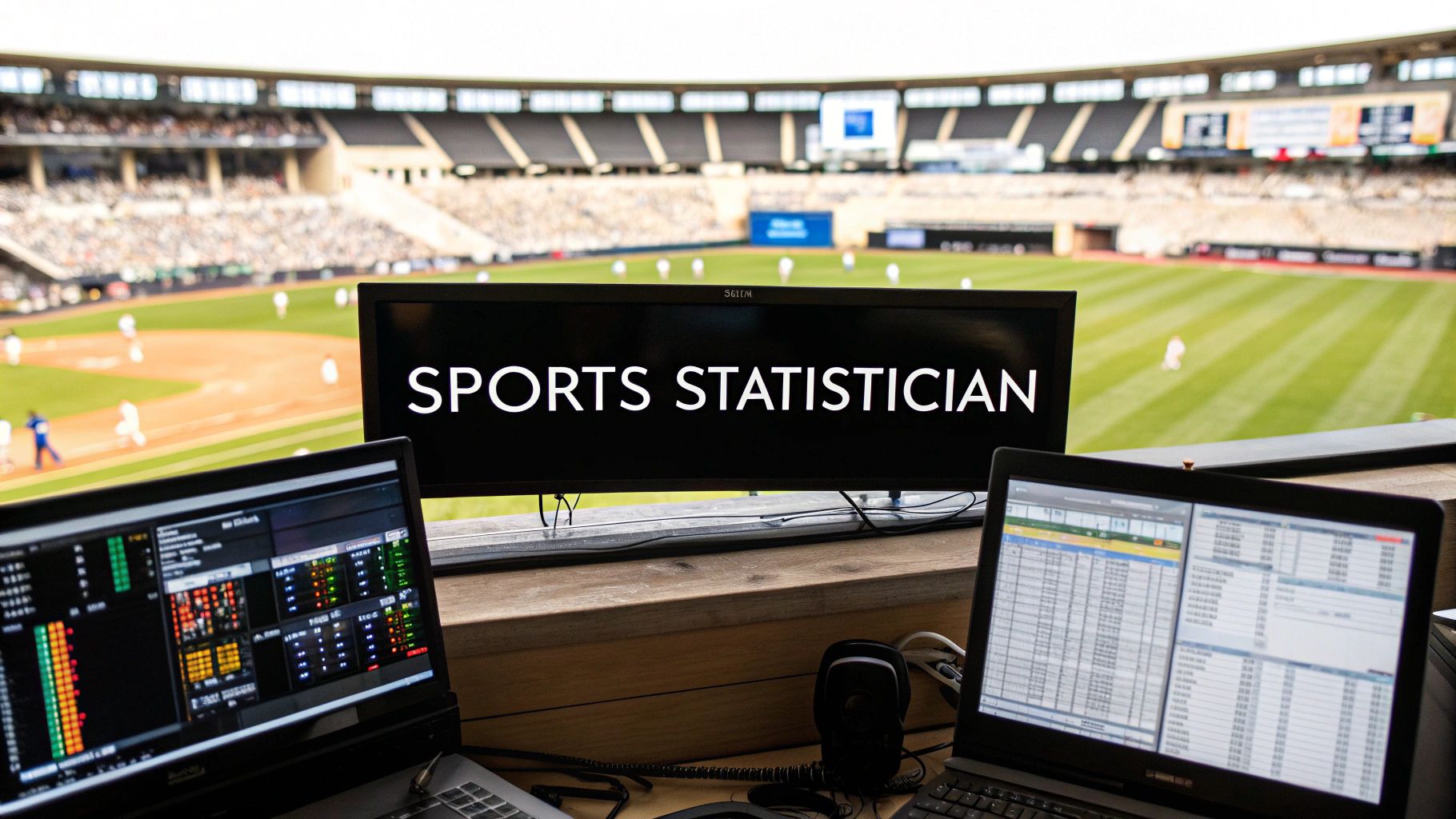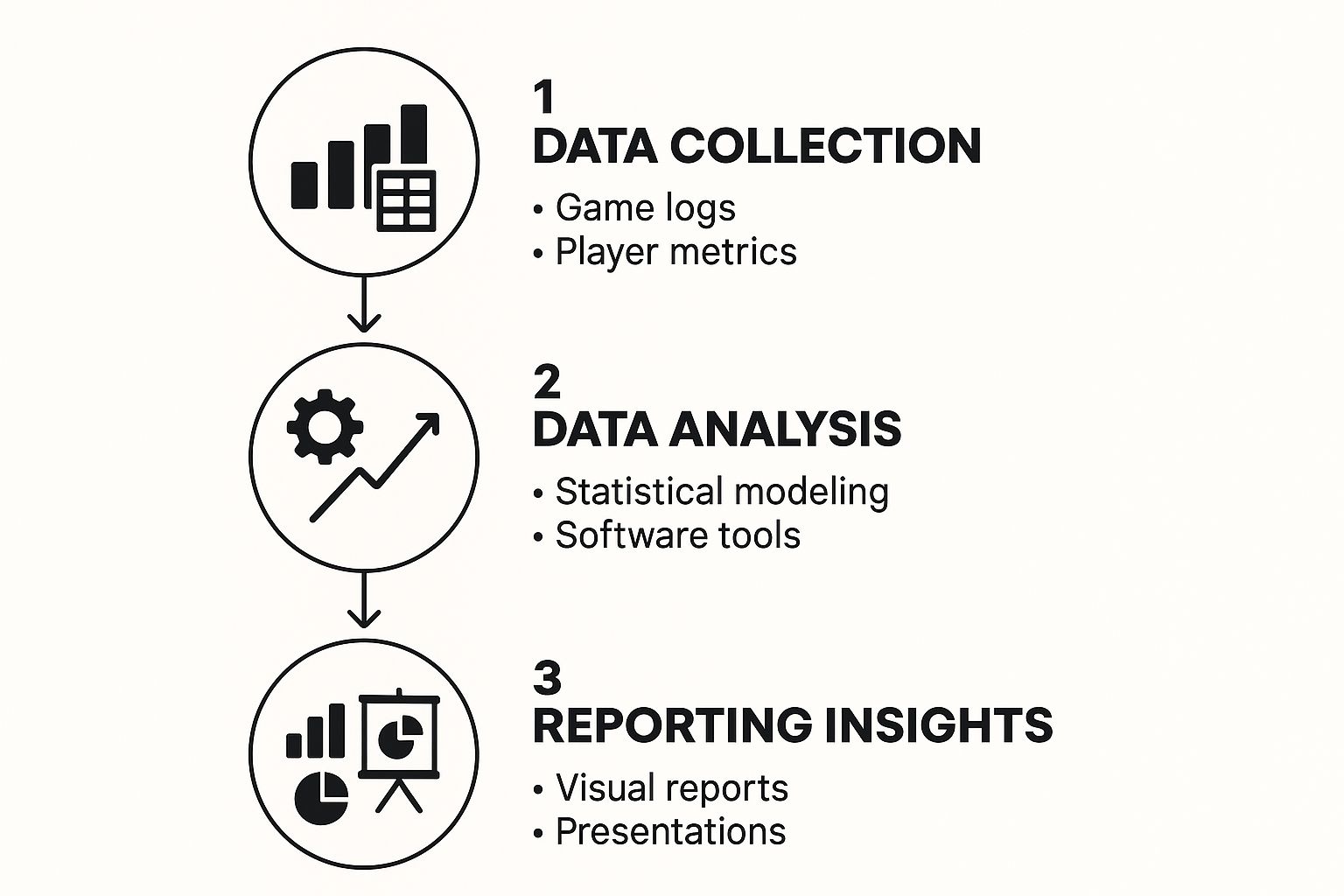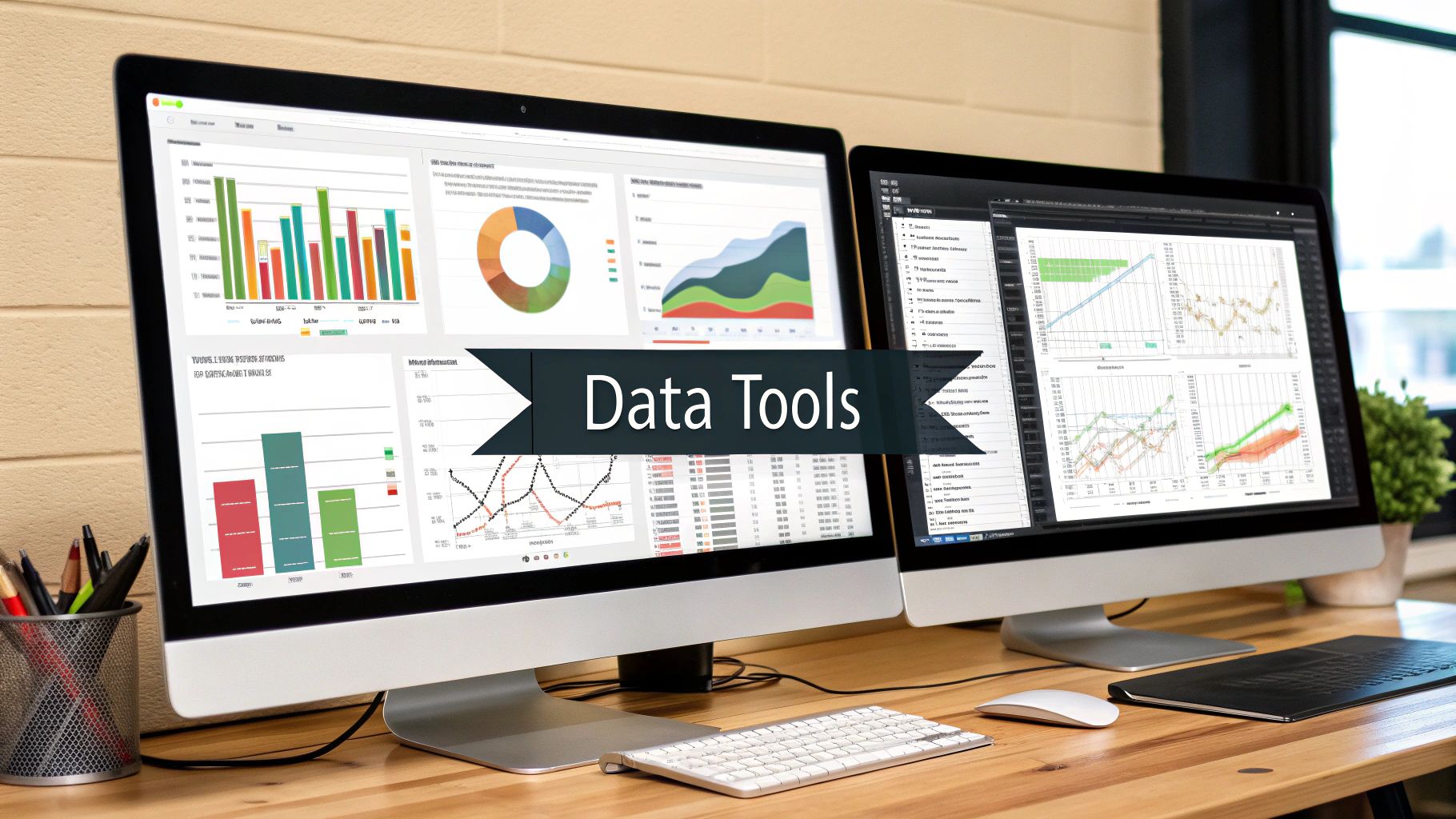
How to Become a Sports Statistician: Your Complete Guide
So, you want to be a sports statistician? It's a killer career that mixes a serious love for the game with the power of data analysis. But let's be clear: this isn't just about memorizing box scores anymore.
Your Roadmap to Becoming a Sports Statistician
Forget the old-school image of a numbers guy buried in spreadsheets. Today's sports statistician is more of a data storyteller, the person in the room who can spot the hidden patterns and predictive insights that give a team its winning edge. It's a field that demands real quantitative skill, but also a deep, intuitive feel for the sport itself.
Your path from passionate fan to professional analyst is all about building a specific set of skills that teams, media outlets, and betting companies are desperately looking for.
Getting the Fundamentals Right
First things first, you need a solid educational foundation. Most pros in this field have at least a bachelor's degree in something quantitative. Think:
- Mathematics
- Statistics
- Computer Science
- Data Science
This isn't just a box to check. Your degree is where you'll build the theoretical muscle needed to tackle complex sports data. But the classroom is only the beginning. You absolutely have to get your hands dirty with programming languages like Python or R. These are the go-to tools for modern sports analysis.
This infographic gives you a high-level look at what the day-to-day work actually involves.

As you can see, it’s a three-part process. You have to be able to find and collect the raw data, use your skills to analyze it, and—most importantly—communicate what you've found in a way that coaches and executives can actually use.
To give you a clearer picture, I've broken down the major steps of this journey into a table. Think of it as your quick-glance guide to what you should be focusing on at each stage.
Key Milestones on the Path to a Sports Statistician Career
| Milestone | Primary Focus | Key Outcome |
|---|---|---|
| Education | Building a strong quantitative foundation. | A bachelor's or master's degree in a field like statistics, math, or computer science. |
| Technical Skills | Mastering essential programming and database tools. | Proficiency in Python or R, SQL, and data visualization software like Tableau. |
| Portfolio Building | Applying your skills to real sports data. | A collection of unique projects that showcase your analytical abilities and sports knowledge. |
| Networking | Connecting with professionals in the industry. | Building relationships on platforms like X (Twitter) and LinkedIn to find mentors and job leads. |
| Job Search | Actively seeking and applying for relevant roles. | Securing your first position in sports analytics, whether with a team, league, or media company. |
This table lays it all out. Each milestone builds on the last, taking you from having the right credentials to proving you can do the work and finally getting your foot in the door. No one step is more important than the others; they all work together to make you a standout candidate.
Building Your Academic and Quantitative Foundation

Loving sports gets your foot in the door, but it's your command of quantitative principles that actually gets you a job. Seriously. The first real step toward becoming a sports statistician is building an unshakeable academic foundation.
This usually means getting a bachelor’s degree in a field that trains you to think in models, probabilities, and data structures. It's about learning the language that front offices and media companies speak.
The most direct routes are degrees in Statistics, Mathematics, or Data Science. These programs give you the rigorous training needed to understand not just what the numbers say, but why they matter. For example, a solid grasp of probability theory is the engine that drives win prediction models. An understanding of linear algebra is critical for developing sophisticated player rating systems that go far beyond simple averages.
Core Coursework for Aspiring Analysts
When you're picking classes, think like you're building a specialized toolkit. Don't just get a generic math degree. Focus on courses with direct applications in the sports world.
Here's what should be on your radar:
- Probability and Statistical Theory: This is the bedrock. You'll learn about variance, regression, and hypothesis testing—concepts you will use every single day.
- Linear Algebra: This is essential for understanding the math behind advanced metrics and multi-variable player comparisons. Think player value models or team chemistry analytics.
- Calculus: This gives you the foundation for understanding rates of change, which is crucial for modeling things like player development arcs and in-game performance trends.
Beyond your major, a minor in Computer Science will give you a massive advantage. Coding isn't optional in this field; it's a core requirement. I've also seen people do incredibly well with a background in Economics, as it helps you understand the business side of sports, from player contracts to franchise valuation.
The best analysts don't just know how to run a statistical test. They know which test to run and how to translate the results into something a coach can actually use on game day. Your college coursework is where you start building that critical intuition.
Ultimately, your degree isn't just a piece of paper. It's your training ground. It’s where you learn to translate complex numbers into a clear, competitive strategy that helps teams win.
Mastering the Essential Technical Skills and Tools

While your degree builds a great theoretical foundation, your technical toolkit is what you'll use to solve problems every single day. Front offices and media companies aren't just looking for someone who understands statistics; they need someone who can get their hands dirty with data and work efficiently. This is a non-negotiable part of the job.
The ability to code is absolutely central to modern sports analytics. You'll hear the debate between Python and R a lot, but honestly, you just need to be proficient in at least one. Python often gets the nod for its versatility and incredible libraries, while R still has a strong foothold in academic circles and pure statistical research.
This isn't just about learning the syntax of a language. It’s about mastering the specific packages that do the real heavy lifting.
Your Core Programming Toolkit
If you're going with Python, a few libraries are indispensable. Pandas is the workhorse for all data manipulation—think of it as your digital multitool for cleaning, sorting, and restructuring massive datasets, whether it's play-by-play logs or player stat sheets.
Then you have scikit-learn. This is your gateway to machine learning, and it's what you'll use for building predictive models, like forecasting a player's future performance or a team's win probability.
But before you can analyze any data, you have to be able to get it. This is where SQL (Structured Query Language) becomes your best friend. Nearly all valuable sports data is stored in databases. Knowing how to write SQL queries is the fundamental skill you need to pull the exact information you need, leaving the rest behind.
You could be the most brilliant statistical mind in the world, but if you can't pull data from a database or clean a messy CSV file, your ideas will never see the light of day. Practical technical skills are the bridge between theory and impact.
Finally, remember that raw numbers and lines of code rarely convince a coach or a GM. You have to tell a story with your findings. This is where visualization tools like Tableau or Python’s own Matplotlib and Seaborn libraries come in. They allow you to create compelling charts and dashboards that transform complex outputs into clear, actionable insights that a decision-maker can understand in seconds.
Creating a Standout Portfolio with Real Sports Data
Let’s be honest. Your education and skills might get you the interview, but your portfolio is what lands you the job. It's the ultimate proof that you can take all that theory and turn it into something real and insightful.
Think about it from a hiring manager's perspective. Anyone can say they know Python. What really catches their eye is seeing how you used it to uncover a hidden trend in player performance. A great project tells a story. It shows you can ask smart questions, hunt down the right data, and then present your findings in a way that makes people listen. Each project is your case study, proving your value to a team's front office.
Sourcing Your Data
First things first, you need some data to play with. Luckily, you don't need a pro-level subscription to get started. The internet is overflowing with fantastic, free resources if you know where to look.
- Public APIs: Many pro leagues and data providers offer public APIs (Application Programming Interfaces). These give you a direct pipeline to a steady stream of game and player stats.
- Academic and Hobbyist Sites: Websites like Sports-Reference.com (for just about every American sport) and Football-Data.co.uk (for soccer) are absolute goldmines of historical data. They’re perfect for analysis.
- Data Science Platforms: Kaggle is another excellent spot. You can find clean, ready-to-use sports datasets, often bundled with competitions that can spark some great project ideas.
My best advice? Find a dataset that you're genuinely curious about. That curiosity is the fuel for any great project.
A portfolio project that analyzes fourth-quarter efficiency in the NBA is far more impactful than just listing "Python" on your resume. One is a claim, the other is evidence. Your portfolio provides that crucial evidence.
For example, don't just analyze final scores. Dig deeper. Download shot chart data to evaluate a basketball player's effectiveness from different spots on the floor. An analysis like that shows you have multiple skills and would be directly relevant for a role like a basketball data scientist.
Or maybe you build a simple model to predict soccer match outcomes based on team form and historical head-to-head results. It doesn’t have to be perfect, but it proves you understand the entire analytics workflow—from finding and cleaning the data to modeling and visualizing the results.
This is the kind of hands-on experience that employers are desperately looking for. It's what separates the candidates from the new hires.
Getting Your Name Out There and Landing the Job
Let's be real. You can have the slickest skills and a portfolio that would make Daryl Morey weep, but if the right people never see your work, it doesn't mean much. The sports analytics community is a small, tight-knit world. Breaking in means you have to be smart, proactive, and ready to network.
Your first move? Get online. I'm not talking about just scrolling. Platforms like X (formerly Twitter) and LinkedIn are absolutely essential for anyone serious about this field.
Find the analysts, writers, and team staff who work for the organizations you dream of joining. Follow them. But don't just lurk in the background. When they post something interesting, jump into the conversation. Share your own projects and analysis. This isn't just about shouting into the void; it's about building a presence and showing you're part of the community. You'd be surprised how many connections—and even job leads—start from a simple online interaction.
Finding Your Spot in the Lineup
Big-time events like the Sloan Sports Analytics Conference are the epicenter of the industry. Even if you can't attend in person, follow the chatter online. See what research is being presented and who's presenting it. These are the people pushing the boundaries of sports statistics.
When you start digging into job boards, you need to read between the lines. Teams are almost always looking for that magic combination of technical skill and an obsessive level of sports knowledge.
So, ditch the generic resume. Tailor every single application. If a job description mentions a specific need, make sure your resume and cover letter highlight a project from your portfolio that directly addresses it. For instance, if you're eyeing a basketball analytics intern role, your basketball-related work needs to be front and center.
A polished resume might get your foot in the door, but a powerful network and a portfolio that speaks their language are what get you a seat at the table. You have to prove you belong.
Finally, you need to understand the money side of things. According to ZipRecruiter, the average salary for a sports statistician hovers around $86,921 a year. Entry-level gigs might start closer to the $57,500 mark, but the top dogs in major league front offices can pull in over $116,000. Knowing these numbers helps you size up offers and plan your career moves.
Common Questions About a Career in Sports Statistics
As you start plotting out your path, you'll find the same questions tend to surface again and again. Let's get right into them.
Answering these now will help you fine-tune your approach and set realistic expectations. It's all about understanding the little details of the job market and figuring out how to position yourself for the best shot at success.
Do I Need a Master’s Degree to Become a Sports Statistician?
A bachelor's is usually the ticket to get in the door, but a master's or PhD can be a massive advantage. This is especially true if you're aiming for those hyper-competitive roles in a pro team's front office, where they expect you to have a deep command of machine learning and predictive modeling.
But an advanced degree isn't the only way. For plenty of roles, especially in media or at the entry-level, a killer portfolio stuffed with practical projects can be just as impressive. It shows you can do the work, simple as that.
What Is the Difference Between a Sports Statistician and a Data Scientist?
Honestly, the lines are getting pretty blurry these days, but there’s still a subtle difference. A traditional sports statistician often digs into historical data—they’re focused on what happened and why. A sports data scientist, on the other hand, is usually building models to predict what will happen.
In the real world, most modern analytics jobs are a mix of both. Data scientists are expected to have sharper coding and machine learning chops, while statisticians might have a more profound grasp of formal statistical theory. The best candidates coming into the field today are strong in both.
Passion is the context engine. You can teach someone to run a regression model, but you can't teach them the intuitive understanding that comes from loving the game. This passion is what separates good analysis from truly game-changing insights.
Can I Succeed Without Being a Huge Sports Fan?
Technically, yes, if your quantitative skills are truly world-class. But you’d be putting yourself at a huge disadvantage. In sports analytics, context is everything. Knowing why the numbers are what they are is how you make real discoveries.
Think about it: recognizing a player’s low shooting percentage is because he’s constantly heaving up desperation shots at the end of the shot clock requires knowing the game. Without that context, you're just looking at numbers without the story.
A genuine passion for the sport is the lens you need to spot those unique insights. It’s what teams are looking for in roles like a Business Intelligence Fellow in community hockey.
Ready to turn your passion for sports and data into a career? Sportsjobs Online is your go-to source for the latest job openings in sports analytics, data science, and technology. Find your dream job with top teams and companies at https://www.sportsjobs.online.
Hundreds of jobs are waiting for you!
Subscribe to membership and unlock all jobs
Sports Analytics
We scan all major sports and leagues
Updated Daily
New jobs are added every day as companies post them
Refined Search
Use filters like skill, location, etc to narrow results
Alerts
You can get daily alerts in your email for a specific search
Access to job postings from top teams and companies
Daily updates and notifications based on your preferences
🎯 Over 90% of customers chose to renew their subscriptions after the initial sign-up
Monthly
$6.99
per month
✓ Flexible monthly billing
✓ Unlimited access to all jobs
✓ Advanced filtering tools
✓ Daily job alerts
✓ Exclusive discount codes
✓ Cancel anytime
BEST VALUE
Yearly
$39
per year • Only $3.25/mo
✓ Save 50% vs monthly
✓ Unlimited access to all jobs
✓ Advanced filtering tools
✓ Daily job alerts
✓ Exclusive discount codes
✓ Cancel anytime
Lifetime
$59
one-time • forever
✓ Pay once, access forever
✓ Unlimited access to all jobs
✓ Advanced filtering tools
✓ Daily job alerts
✓ Exclusive discount codes
✓ Best long-term value